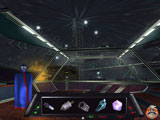 I’ve always felt that a game’s box is one of its more
important features. The text of the box, the
graphics splashed across its front, the way the colors look together as they proudly show
off screen-shots from the actual game; these are the first impression-giving features
gamers see. As the game rests quietly on the
shelf, before all the sound and color contained within has a chance to leap out and amaze
us, the moods set by the contents of the box are the only selling features it has. It’s sort of like dressing for a first date. You can dress how you like, casual, sloppy,
cheerful, dark, formal, but never, ever, under any circumstances do you dress… well…
like The Ward. My initial hopes for the game
fell as I read the first incomplete sentence on the back of the box, and then dropped even
more as I came across the spelling errors in the small manual (three that I counted
offhand). After a good perusing over lunch, I
set the game on my desk, where it remained untouched for nearly three days. After all, if they couldn’t dress right for
our first meeting, what could I expect from the actual date? I would probably end up with bouquet of plastic
flowers (sure, they may last longer, but they
just don’t smell right). I’ve always felt that a game’s box is one of its more
important features. The text of the box, the
graphics splashed across its front, the way the colors look together as they proudly show
off screen-shots from the actual game; these are the first impression-giving features
gamers see. As the game rests quietly on the
shelf, before all the sound and color contained within has a chance to leap out and amaze
us, the moods set by the contents of the box are the only selling features it has. It’s sort of like dressing for a first date. You can dress how you like, casual, sloppy,
cheerful, dark, formal, but never, ever, under any circumstances do you dress… well…
like The Ward. My initial hopes for the game
fell as I read the first incomplete sentence on the back of the box, and then dropped even
more as I came across the spelling errors in the small manual (three that I counted
offhand). After a good perusing over lunch, I
set the game on my desk, where it remained untouched for nearly three days. After all, if they couldn’t dress right for
our first meeting, what could I expect from the actual date? I would probably end up with bouquet of plastic
flowers (sure, they may last longer, but they
just don’t smell right). 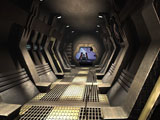 So imagine my surprise when I finally launched the game to find
myself presented with a fist full of pretty carnations; sure, they weren’t roses, but
you can’t complain. The Ward opens with
a mood setting cut scene, and then deposits you in control of David Walker, an American
astronaut who finds himself captured by aliens while visiting the moon (sucks to be you). And here is the surprise. This is a space adventure game that, despite a few
very obvious flaws, carries with it an engagingly unsettling atmosphere, solid puzzles
(mostly), and a progressive story line that makes it a pretty darn good game. Guess my mom was right again. Never judge a book by its cover. So imagine my surprise when I finally launched the game to find
myself presented with a fist full of pretty carnations; sure, they weren’t roses, but
you can’t complain. The Ward opens with
a mood setting cut scene, and then deposits you in control of David Walker, an American
astronaut who finds himself captured by aliens while visiting the moon (sucks to be you). And here is the surprise. This is a space adventure game that, despite a few
very obvious flaws, carries with it an engagingly unsettling atmosphere, solid puzzles
(mostly), and a progressive story line that makes it a pretty darn good game. Guess my mom was right again. Never judge a book by its cover.
To start with, The Ward’s
game controls are simple and easy to use. You
control your character from above in a style that will be familiar to most who have played
adventure games before. The cursor lights up
and displays a label whenever it passes over anything the character can interact with,
including people and your inventory, which you access through a button at the bottom of
the screen. Except for Walker’s
inability to run (if I saw an alien with a laser gun, I’d figure out how to run real
fast, but that’s just me), I found the interface to be smooth and easy to control.
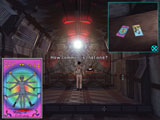 The strengths of the game begin to show within the
opening scenes, from the moment you wake in the heart of the alien moon base. Around you a war seems to be taking place. The doors of your chamber have been blown open,
your alien guards lay dead, along with the remains of another human. Bodies lay strewn in the hallway, their alien
carcasses shot through by energy weapons. The
lights in the ceiling above you flicker, the dark corridors seem empty, and yet the dead
are an indication that something must still be around.
This is a game that is best started after dark, with the lights down and
your back exposed to a window. Make sure you
go ahead and give yourself enough time to get fully engrossed in the game. You’ll be happy you did. I found myself jumping at odd sounds after an hour
of play, and that night I went to bed in a room that was mysteriously less secure than it
had been before I had begun playing. Yeah, it
may have been a pretty dark date, but it was a date that left an impression. The strengths of the game begin to show within the
opening scenes, from the moment you wake in the heart of the alien moon base. Around you a war seems to be taking place. The doors of your chamber have been blown open,
your alien guards lay dead, along with the remains of another human. Bodies lay strewn in the hallway, their alien
carcasses shot through by energy weapons. The
lights in the ceiling above you flicker, the dark corridors seem empty, and yet the dead
are an indication that something must still be around.
This is a game that is best started after dark, with the lights down and
your back exposed to a window. Make sure you
go ahead and give yourself enough time to get fully engrossed in the game. You’ll be happy you did. I found myself jumping at odd sounds after an hour
of play, and that night I went to bed in a room that was mysteriously less secure than it
had been before I had begun playing. Yeah, it
may have been a pretty dark date, but it was a date that left an impression.
However, the mood of a graphic adventure is only part of the over-all story. This means that not only the atmosphere, but also
the puzzles and meat of the game have to hold up to scrutiny. The Ward holds up surprisingly well, with a few
exceptions. In most cases the puzzles fit
well into the story line, are logical to the progression of the goal at hand, and make
sense when compared to the context in which they appear.
The solutions to the puzzles, while not always easy, follow a logical flow. You rarely find yourself wondering, “Why did
I have to do that?”
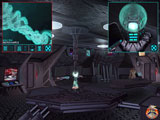 Though
you do occasionally find yourself trying to open a door by operating a slide puzzle (as if
an advanced alien civilization really couldn’t
figure out numbered keypads?), the majority of the challenges in the game are well thought
out and well executed. Even when the quality
of the puzzles and the intensity of the action decrease temporarily near the middle of the
game, The Ward still manages to successfully integrate mood, graphics, and puzzles to
produce an enjoyable adventure experience. Though
you do occasionally find yourself trying to open a door by operating a slide puzzle (as if
an advanced alien civilization really couldn’t
figure out numbered keypads?), the majority of the challenges in the game are well thought
out and well executed. Even when the quality
of the puzzles and the intensity of the action decrease temporarily near the middle of the
game, The Ward still manages to successfully integrate mood, graphics, and puzzles to
produce an enjoyable adventure experience.
For all its
strengths, however, there are certain major flaws that are evident all throughout The
Ward. While the programmers seemed to know
what they were doing, and the graphic designers managed to make some pretty cool scenes,
the actual story, the explanation to the player of what’s going on in the game, is
miserably told. The dialogue is poorly
written, the identification of characters is horrible (I’m still confused who certain
people were, or what exactly they were doing in the game), and the alien speech sounded
anything but alien. Sure, the game
addressed solid technical details such as language barriers (an alien implant allows you
to understand what the aliens say), but they didn’t adequately explain why it was
that the aliens often sounded like a couple of teenager actors with a bad screenwriter. The poor grammar and writing skills that were
evident on the back of the box and throughout the manual make appearances almost every
time the story must be narrated by extended text. If
it were not for the story told in the manual (which, by the way, describes the entire plot
in advance, including everything that happens if you correctly complete all the puzzles) I
would have had no idea at all what exactly was going on.
At the same time, if the manual had
been well written it would have completely destroyed any sense of mystery or anticipation
that was included with the game. As it was,
the poor writing left me vague in relation to the story line, so that even now I’m
uncertain exactly what happened.
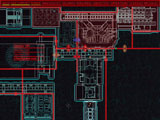 Another complaint I have deals with the save
feature. Between the automatic save and the
quick save features (not to mention the quick load) I lost my crucial saves once every few
hours. The system seemed to successfully
quick save the game only about half the time, and then would automatically write over the
few that were saved correctly. I finally
ditched the quick save feature entirely, falling back on manually loading the menu every
time I grew nervous. Another complaint I have deals with the save
feature. Between the automatic save and the
quick save features (not to mention the quick load) I lost my crucial saves once every few
hours. The system seemed to successfully
quick save the game only about half the time, and then would automatically write over the
few that were saved correctly. I finally
ditched the quick save feature entirely, falling back on manually loading the menu every
time I grew nervous.
Overall, The Ward
was a competent adventure game with a wonderfully dark atmosphere that drew me into the
game, and kept me there. While the story is
poorly told, the puzzles are mostly well thought out, and the story progresses at a solid
pace. The grammatical and writing errors
aside, the clumsy box ignored, The Ward came bearing a fist full of real-smelling flowers. So when looking this game over, try not to be too
afraid of the box. There’s more to it
than meets the eye.
Aaron
Stanton |
